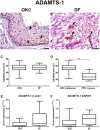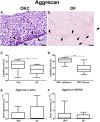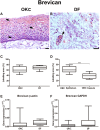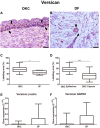Gene expression and immunohistochemistry analysis of ADAMTS-1 and its substrates in odontogenic keratocyst
- PMID: 39762885
- PMCID: PMC11705738
- DOI: 10.1186/s13000-024-01576-0
Gene expression and immunohistochemistry analysis of ADAMTS-1 and its substrates in odontogenic keratocyst
Abstract
Background: Considering the significant participation of the microenvironment in the local aggressiveness of odontogenic keratocysts, this study aims to evaluate the expression of ADAMTS-1 and its substrates, versican, aggrecan and brevican in this locally invasive odontogenic cyst.
Methods: Immunohistochemistry and polymerase chain reaction (PCR) were conducted on 30 cases of odontogenic keratocysts (OKCs) and 20 dental follicles (DFs).
Results: The immunohistochemical expression of these proteins was predominantly cytoplasmic and granular across all samples. In epithelial tissue, the immunoexpression of aggrecan and versican was higher in OKC (p < 0.05) compared to DF. Comparing the expression of proteins between the OKC epithelium and the cystic capsule, it was observed that all molecules were more expressed in the epithelium (p < 0.001). RT-PCR confirmed the expression of ADAMTS-1 and proteoglycans in all samples.
Conclusion: ADAMTS-1, aggrecan, brevican, and versican were expressed in all samples with a granular and cytoplasmic pattern. RT-PCR confirmed their presence in both OKC and DF, but only aggrecan and versican exhibited significantly higher levels in OKC (p < 0.05). Protein expression was notably greater in the epithelial component of OKC. These findings underscore the potential role of these proteins in the biological behavior of OKC.
Keywords: ADAMTS-1; Immunohistochemistry; Odontogenic keratocyst; Proteoglycans.
© 2024. The Author(s).
Conflict of interest statement
Declarations. Ethics approval and consent to participate: this study was approved by the Ethics Committee of the Institute of Oncology Research Center of the Federal University of Pará (n°2.371.646). Consent was obtained from patients for use of their samples. Consent for publication: not applicable. Competing interests: The authors declare no competing interests. Declaration of generative AI and AI-assisted technologies in the writing process: During the preparation of this work the authors used ChatGPT (version GPT-4) only to improve readability and language. After using this tool, the authors reviewed and edited the content as needed and take full responsibility for the content of the publication.
Figures





Similar articles
-
Distribution and processing of a disintegrin and metalloproteinase with thrombospondin motifs-4, aggrecan, versican, and hyaluronan in equine digital laminae.Am J Vet Res. 2012 Jul;73(7):1035-46. doi: 10.2460/ajvr.73.7.1035. Am J Vet Res. 2012. PMID: 22738056 Free PMC article.
-
Expression of BMP4 and FOXN1 in orthokeratinized odontogenic cyst compared to odontogenic keratocyst suggests an epidermal phenotype.Biotech Histochem. 2022 Nov;97(8):584-592. doi: 10.1080/10520295.2022.2048073. Epub 2022 May 9. Biotech Histochem. 2022. PMID: 35527675
-
Absence of BRAFV600E immunohistochemical expression in sporadic odontogenic keratocyst, syndromic odontogenic keratocyst and orthokeratinized odontogenic cyst.J Oral Pathol Med. 2020 Nov;49(10):1061-1067. doi: 10.1111/jop.13081. Epub 2020 Jul 18. J Oral Pathol Med. 2020. PMID: 32589764
-
A systematic review on the expression of bcl-2 in the nonsyndromic odontogenic keratocyst: should it be considered a cyst or a tumor?Oral Maxillofac Surg. 2020 Sep;24(3):277-282. doi: 10.1007/s10006-020-00856-5. Epub 2020 Jun 3. Oral Maxillofac Surg. 2020. PMID: 32488544
-
An immunohistochemical study of the lining epithelium of odontogenic keratocyst.J Nihon Univ Sch Dent. 1995 Sep;37(3):163-9. doi: 10.2334/josnusd1959.37.163. J Nihon Univ Sch Dent. 1995. PMID: 7490610 Review.
References
-
- Pogrel MA. (2013). The keratocystic odontogenic tumor. Oral and maxillofacial surgery clinics of North America, 25(1), 21–30, v. 10.1016/j.coms.2012.11.003 - PubMed
-
- Kaczmarzyk T, Stypułkowska J, Tomaszewska R. Update of the WHO classification of odontogenic and maxillofacial bone tumors. J Stomatology. 2017;70(5):484–506.
-
- WHO Classification of Tumors Editorial Board. Head and Neck Tumours. 5th ed. Lyon: IARC; 2024.
-
- Stoelinga PJW. Keratocystic odontogenic tumour (KCOT) has again been renamed odontogenic keratocyst (OKC). Int J Oral Maxillofac Surg. 2019;48(3):415–6. - PubMed
-
- Mendes RA, Carvalho JF, van der Waal I. Characterization and management of the keratocystic odontogenic tumor in relation to its histopathological and biological features. Oral Oncol. 2010;46(4):219–25. 10.1016/j.oraloncology.2010.01.012. - PubMed
MeSH terms
Substances
Grants and funding
LinkOut - more resources
Full Text Sources
Miscellaneous

